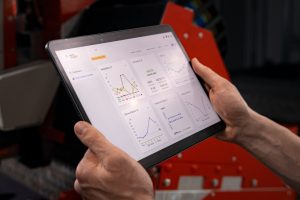 Today’s modern metal cutting and bending machines can communicate production data directly to manufacturing software that will segment the data into subsets for analysis. From the time a metal cutting or metal bending machine is operational, it begins to produce production data. Each system message or error message is effectively a subset of that machine’s processes along with the production-related data.
Today’s modern metal cutting and bending machines can communicate production data directly to manufacturing software that will segment the data into subsets for analysis. From the time a metal cutting or metal bending machine is operational, it begins to produce production data. Each system message or error message is effectively a subset of that machine’s processes along with the production-related data.
Modern CNC equipment provides this statistical data in real time and can be analyzed by manufacturing software systems to provide intelligence for manufacturers to continuously improve their processes. Smart statistical analysis software like Bystronic’s BySoft Insights enables users to visualize the Overall Equipment Effectiveness (OEE) metrics through graphical interfaces that drive continuous improvement efforts in manufacturing. It is through these objective measurements that fabricators can improve their processes to remain competitive and profitable.
Objective Decisions
Overall Equipment Effectiveness (OEE) provides the metrics for managers to see the true performance of their machines and where are the areas for improvement. While Manufacturing Execution System (MES) software like Bystronic’s BySoft Shop Floor provides information on jobs in real-time and as they move from one machine to the next, the finite data on the performance of the machine is analyzed by performance metrics such as OEE calculations. With OEE metrics, companies can identify improvement opportunities through analysis and where predictive measures can be implemented to offset unplanned downtimes.
Utilizing a Manufacturing Execution System (MES), like Bystronic’s BySoft Shop Floor software, provides the ability to plan, monitor, and track all the active jobs and machine workloads. This enables managers to react on short notice to ever-changing production requirements. With OEE, standard measures can be compared against actual measures to determine if the process is on track or not. Problems can be identified and corrections can be made immediately in real time before that process is completed.
Flexibility in Routing
Real-time data from each machine provides actual runtime for comparison to target times for each job. The actual production time adjusts the job completion date in real time and is monitored by the MES. Unscheduled delays affecting the job completion date are flagged. Declining machine performance is identified in real time and acted upon immediately by the operator or by maintenance. Re-routing of jobs to an alternate machine can be done on-the-fly to maintain optimal production schedules. Production information such as the current operation of the job within the workflow, how many parts have been produced, and the expected completion of the job are identified from within the MES.
Streamlining for Efficiency and Throughput
In today’s fast-paced production environment, the ability to have a high-level overview and control of all released production jobs, and to monitor their status, is essential to production management and maintaining on-time delivery schedules.
Efforts to streamline front-end processing, reduce non-productive times, and optimize order cycle times contribute significantly to reducing the overall order turnaround time. By incorporating real-time data analysis into the total end-to-end process, companies can achieve higher efficiency and productivity, thereby gaining a competitive edge in the market.
By Frank Arteaga, Regional Director Marketing – Americas
Bystronic Inc., Hoffman Estates, IL
Voice.bystronic@bystronic.com
